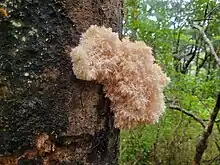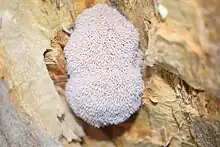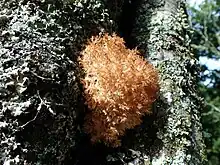Hericium novae-zealandiae
HerIcium novae-zealandiae is a species of fungus in the Hericiaceae family. Formerly classified as Hericium coralloides which shares an almost identical morphology.[1] Being saprotrophic, H. novae-zealandiae can be observed growing from dead, decaying wood.[2] Also known as pekepeke kiore or New Zealand's lion mane, it is endemic to New Zealand and was consumed by indigenous Māori.[3]
| Hericium novae-zealandiae | |
|---|---|
 | |
| Large Hericium novae-zealandiae approaching maturity, with no colour differentiation between stipes and hymenium. | |
| Scientific classification | |
| Domain: | Eukaryota |
| Kingdom: | Fungi |
| Division: | Basidiomycota |
| Class: | Agaricomycetes |
| Order: | Russulales |
| Family: | Hericiaceae |
| Genus: | Hericium |
| Species: | H. novae-zealandiae |
| Binomial name | |
| Hericium novae-zealandiae (Colenso) Chr. A. Sm. & J.A. | |
| Synonyms | |
|
Hydnum novae-zealandiae | |
Description

Hericium novae-zealandiae has a relatively large (10cm + diameter), white fruiting body, initially described (as Hydnum nova zealandia) as looking somewhat like a cauliflower nearing flowering. Lacking a pileus or defined stipe, basidiomata are highly and irregularly branched. Growing from a short, corkish stem, culminating in numerous, densely arranged, fine tips. The hymenium (spore bearing surface) is located on the surface of the fine tips, there is no delineation between the stipe and the hymenium until spore maturity when tips become reddish.[4]
Medicinal

The closely related Hericium erinaceus, or lion’s mane has been shown to have numerous health benefits including treating dyspepsia, gastric ulcers as well as antitumor and immuno-modulatory activity.[3]
Extractions from Hercium novae-zealandiae have been shown to exhibit antiproliferative qualities when applied to three prostate cancer lines cancer lines (DU145, LNCaP and PC3).[5][6] While a polysacharride extract was effective on LNCaP and PC3 lines,[5] an ethanol extract containing the constituents hericenone C, hericene B, ergosterol and ergosterol peroxide was effective on all three.[6] The mechanism in both cases was identified as apoptosis (programmed cell death).[5][6]
References
- Pallua, J. D.; Recheis, W.; Pöder, R.; Pfaller, K.; Pezzei, C.; Hahn, H.; Huck-Pezzei, V.; Bittner, L. K.; Schaefer, G.; Steiner, E.; Andre, G.; Hutwimmer, S.; Felber, S.; Pallua, A. K.; Pallua, A. F. (2012). "Morphological and tissue characterization of the medicinal fungus Hericium coralloides by a structural and molecular imaging platform". The Analyst. 137 (7): 1584–1595. doi:10.1039/c1an15615b. ISSN 0003-2654. PMID 22158509.
- Pallua, Johannes D.; Kuhn, Volker; Pallua, Anton F.; Pfaller, Kristian; Pallua, Anton K.; Recheis, Wolfgang; Pöder, Reinhold (2015). "Application of micro-computed tomography to microstructure studies of the medicinal fungus Hericium coralloides". Mycological Society of America. 107 (1): 227–238. doi:10.3852/14-188. ISSN 0027-5514. PMID 25376797. S2CID 32198634.
- Chen, Zhixia; Buchanan, Peter; Quek, Siew Young (2021-08-16). "Identification and Determination of Compounds Unique to Hericium in an Edible New Zealand Mushroom Hericium novae-zealandiae". Food Analytical Methods. 15 (1): 67–74. doi:10.1007/s12161-021-02098-x. ISSN 1936-9751. S2CID 237101319.
- Colenso, W (1888). "Description of some newly-discovered Crypto-gramic Plants: being further Contribution towards making known the Botany of New Zealand". New Zealand Institute of the Transactions and Proceedings. 21: 79 – via Biodiversity Heritage Library.
- Chen, Zhixia (Grace); Bishop, Karen Suzanne; Tanambell, Hartono; Buchanan, Peter; Quek, Siew Young (2019-07-08). "Assessment of In Vitro Bioactivities of Polysaccharides Isolated from Hericium Novae-Zealandiae". Antioxidants. 8 (7): 211. doi:10.3390/antiox8070211. ISSN 2076-3921. PMC 6680813. PMID 31288400.
- Chen, Zhixia (Grace); Bishop, Karen Suzanne; Tanambell, Hartono; Buchanan, Peter; Smith, Chris; Quek, Siew Young (2019). "Characterization of the bioactivities of an ethanol extract and some of its constituents from the New Zealand native mushroom Hericium novae-zealandiae". Food & Function. 10 (10): 6633–6643. doi:10.1039/c9fo01672d. ISSN 2042-6496. S2CID 203439525.